There’s no stopping the impending march of electrification, as even the two-wheeled world is busy turning its back on the combustion engine and looking at ways to embrace batteries and electric motors.
Harley-Davidson unleashed its LiveWire to the general public back in 2019, while the likes of Kawasaki, KTM and BMW all now offer electrified two-wheelers… and that’s before we mention the likes of Maeving, Ryvid and Energica, all of whom have sprung up in the intervening years.
However, Zero has arguably been at the forefront of the electric motorcycle world since 2006, when former NASA engineer Neal Saiki decided that bikes are likely only going the same route as passenger cars, so he started experimenting with basic battery set-ups.

Early models were, erm, rudimentary to say the least, but the company has made exceptional progress over the past 10 years. Its fully electric model line-up now encompasses some nine machines – a number far greater than any rival – while its battery and motor technology has matured to the point where it can genuinely hold its head high against internal combustion engine competition.
This year brings with it some of the biggest revisions to the line-up so far, including larger battery packs, improved range and an overall sense of upgraded components and build quality.
The DSR, ridden here, was the world’s first electric adventure bike when it was first launched and, despite now being joined by the Energica Experia, it remains the more affordable (and adaptable) machine for on and off-road exploits.
Specs appeal

Let’s start with some basic numbers, shall we? The DS (Dual Sport) line encompasses the DS, the DSR and the range-topping DSR/X, with the only real distinguishing features being the battery pack capacity.
The line-up kicks off with 14.4kWh, expands to 15.6kWh in the DSR model and tops out at 17.3kWh in the halo DSR/X model. This, in turn, impacts the power, top speed and electric range on offer.
The DS can manage around 98 miles on the highway, perhaps the most energy-sapping of all riding conditions, while clocking up a top speed of 86mph and delivering 60hp of peak power or 15hp of continuous power.
This latter figure makes it compliant on an A1 license in the UK, or similar in the US and further afield, which means younger riders only have to perform very basic practical tests to legally ride one.

Better still, Zero has designed its bikes so additional power can be unlocked at dealer level, so the machine gets more potent as the rider ticks off the various licenses and legalities required to ride the most powerful bikes.
With that in mind, the DSR model is A2 license compliant in the UK, producing 70hp of peak power (44hp of continuous power), hitting a 93mph top speed and delivering 100 miles of range on the highway.
Finally, the range-topping DSR/X is designed for full motorcycle license holders and offers a whopping 100hp of peak power (48hp continuous), a 112mph top speed and 107 miles of Highway commuting range.
All 2024 Zero models are now manufactured at IMI in the Philippines, as opposed to Zero’s smaller and less capable facilities in California. According to the brand, this has enabled them to increase production capacity, drastically improve quality control and cut the delivery lead times down to a matter of weeks, rather than months.
Silent assassin
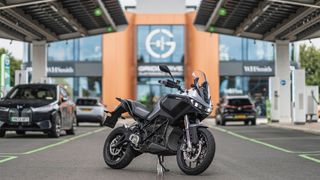
I’ll be the first to admit that adventure bikes aren’t really my cup of tea. As a vertically-challenged human being, they are often tall, heavy and daunting things to throw a leg over, but Zero does a fantastic job of disguising this.
At just 828mm, it is among the lowest standard seat heights out there, coming up slightly shorter than the Ducati Multistrada V2 and BMW F 900 GS Adventure. The overall ergonomics of the DSR range are well thought out – the handlebars are within easy reach and the chassis seems to cocoon around the rider.
Better still, the chunky battery pack, which makes up a large percentage of the bike’s overall weight, is mounted low down, so the centre of gravity feels well balanced. Pulling up at lights, it’s amazing how well you can balance the machine using just mild brake and throttle inputs.
Granted, the 235kg wet weight is by no means light, but it is disguised well and, being electric, the rider can select both forward and reverse parking modes, which assist in moving the bike at a crawling pace via the throttle.
Out on the open road, the DSR/X I tested felt extremely well planted and predictable, with that low center of gravity helping to confidently tip the bike through corners. Plus, with 113hp on tap, it absolutely rocketed from rest to 60mph.
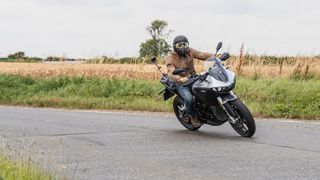
Zero offers a number of riding modes that are easily selected via a toggle switch on the bars. There’s Eco, which sees maximum regenerative braking and a slightly milder throttle power delivery to eke the most out of the batteries.
A Sport mode kills off the regenerative braking completely and unleashes full power, making it ride like a thumping two-stroke machine of yesteryear with little in the way of engine braking.
Rain mode ensures the rear wheel doesn’t spin up at every opportunity thanks to gentle throttle mapping and Normal sits somewhere in the middle of everything.
Canyon mode, on the other hand, can be configured via the brand’s excellent Cypher III+ OS and smartphone app, which allows full control over all performance, Bosch-engineered traction control and ABS perameters. As standard, it sees maximum power and max regen braking offered.
This was my preferred setting, as it felt the closest to a large internal combustion engine bike – one that offers a decent amount of engine braking when rolling off the throttle.
One bike to rule them all
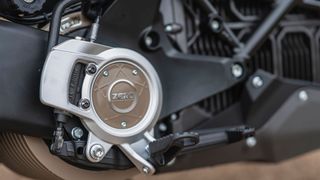
As previously mentioned, Zero prides itself on the fact that its machines can grow alongside the rider. Admittedly, mechanically restricting an ICE bike so it is A2-license-friendly has been the norm for many years, but Zero arguably goes several steps further.
For example, many of Zero’s models can be restricted via software so they are compatible with the most basic riding licenses, despite looking and feeling like a “full-size” bike. These can then be tweaked to unlock more power as the licensing allows. Alternatively, don’t bother unlocking the power but bask in the fact that your bike doesn’t look like a learner-friendly scooter or moped.
What’s more, even the charging speed of the battery pack isn’t set in stone, as customers can option an additional “Charge Tank” that increases the rate at which the bikes devour electricity. But we’ll get into that later.
Above all else, Zero wants to get away from the fact that its offerings simply make for excellent, economically-sound commuter machines, despite the obvious savings that can be made on fuel and maintenance (they require an average of just 45 minutes servicing per year), and instead ram home the fact they are also enjoyable motorcycles to ride in their own right.
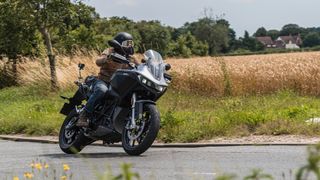
This really comes through with the latest models, which now feel like genuine internal combustion engine contenders, rather than the slightly cheap and rattly toys of previous generations.
Hopping on and off the various models in the DS line-up, it was easy to feel the performance differences between them all, but the overarching feeling of riding a premium adventure motorcycle permeated through the entire range.
The Showa suspension system offers full adjustment over 190mm of travel, meaning it felt capable of soaking up some mild off-road terrain. The J-Juan brakes offered plenty of stopping power, especially given the blending with the regenerative braking system, while all bikes came fitted with premium Pirelli Scorpion Trail II tires for maximum traction and heated grips, selected via the OS.
Wafting along the blacktop in near silence only seemed to heighten the senses and add to the therapeutic nature of riding a motorcycle. Get a good helmet and there’s little need for ear plugs, just wind noise and the open road. It’s quite the experience.
Range anxiety

Despite automotive manufacturers pushing EVs for over a decade now, range anxiety is still one of the biggest stumbling blocks for potential owners. If you thought it was bad in the four-wheeled world, try convincing ardent bikers to make the electric switch.
Dale Robinson, Zero’s Country Manager, told me Zero sold just 300 bikes in the UK last year, citing Covid and the tough market conditions in general as reasons, but in reality, it’s because many bikers just aren’t interested.
This is compounded by the fact that the DSR/X model I tested starts at $22,995/£20,950 (or around AU$35,000), making it more expensive than similar gasoline bikes from Triumph, Ducati and BMW.
But perhaps the biggest issue is charging speeds, because most Zero models charge at around 3kW, which is painfully slow by modern standards. Even the average home wall charger now kicks out 7kW.
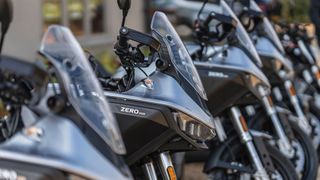
Zero will extend to 6kW charging speeds in the more expensive models and this figure can be extended further by selecting an optional 6kW Charge Tank, which eats into the lockable storage space but means the fastest rapid charging is around 13kW.
Alternatively, Zero also offers a 3.6kWh Power Tank, which adds a little extra battery capacity, but this can’t be specified if you option the Charge Tank. It begs the question why Zero doesn’t just offer the fastest charge speeds to everyone and be done with it, but it’s likely a way of keeping base prices down.
Whichever option you choose, riding big miles will still require most owners to hang around for 45 minutes to an hour in order to brim a battery from most public fast charging outlets, which will feel too long for many, especially considering the highway range is only around 100 miles. That’s a stop every hour or so during those longer adventures.
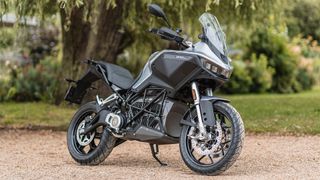
That said, it is possible to eke a lot more from the battery packs, especially when cruising around town in stop/start traffic. During our test ride, we managed several hours of twisting country roads with just one charge in between.
Robert Portman, marketing specialist for Zero said: “If you return home with anything more than 10 per cent battery, you’ve wasted time charging,” suggesting that riders should only brim for what they need.
Despite this, it still rules out the most adventurous, continent-crossing missions, unless you are prepared for frequent and relatively long stops.
The future is bright
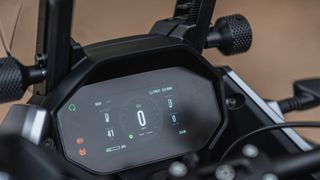
In the big bike world, EV progress has been slower than it has in both passenger cars and even small capacity scooters, where things like battery swap tech and leasing deals have made them more attractive than petrol equivalents.
Ownership of larger capacity electric bikes is expensive, the range is still limited, charging is slow and, in many regions, insurance costs can be astronomic, simply because brokers have no real data upon which to set prices.
These are all very real struggles Zero faces to this day, but at least the company doesn’t have to worry about the quality of its product. The Zero DSR/X is a joy to ride and can genuinely compete with petrol-powered rivals from established brands in terms of performance and ride quality.
In fact, I’d argue it’s even easier to live with and would provide the perfect introduction to motorcycling for many, removing the potentially daunting thought of a big, snarling combustion engine and replacing it with something altogether smarter and more serene.
If the future of electric motorcycling can progress at the unrelenting pace Zero has set, things look genuinely exciting. We are just not quite there yet.
You might also like
Services Marketplace – Listings, Bookings & Reviews
